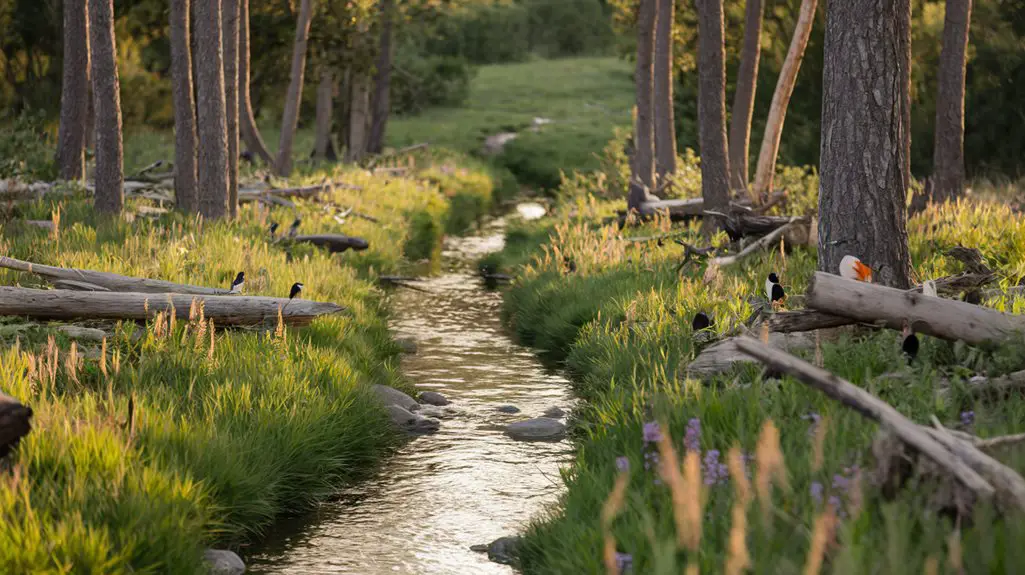Did you know that effective wildlife corridors can boost biodiversity by up to 40%? By integrating native plant selections, you not only provide essential food and shelter for local wildlife but also promote ecosystem stability. Water features like ponds offer significant support for various species. Constructing safe passageways, utilizing natural shelters such as hedgerows, and establishing butterfly gardens are fundamental steps. Each element plays an essential role in fostering a balanced environment. Curious about how? Let's explore further…
Native Plant Selection
When planning a wildlife corridor, choosing native plants is essential to fostering a healthy and sustainable ecosystem. By selecting flora native to your region, you're supporting local wildlife that has evolved alongside these plants for thousands of years.
Native plants provide food, shelter, and breeding grounds for birds, insects, and mammals. They're well-adapted to your area's soil, climate, and water conditions, which means less maintenance, fewer resources, and no harmful chemicals.
You'll foster biodiversity since native species encourage a broader range of wildlife. They strengthen the corridor's resilience against invasive species.
Additionally, native plants help conserve water and improve soil health through natural processes. Creating a wildlife-friendly garden will enhance the overall effectiveness of your corridors in supporting ecological balance. Your dedication to native plant selection will create corridors that thrive naturally and support ecological balance.
Water Feature Integration
Incorporating water features into your wildlife corridor can dramatically enhance biodiversity and create a dynamic ecosystem. You might consider adding ponds, streams, or simple birdbaths.
These elements provide essential hydration sources, breeding grounds, and habitats for various species such as frogs, birds, and insects. A pond can attract dragonflies that prey on pests like mosquitoes, promoting a balanced environment.
By integrating native plant species around the water, you're offering shelter and food, further enticing wildlife. Be sure to design gradual banks for easy access and include gravel at the bottom to assist non-aquatic creatures.
Additionally, water features can serve as a magnet for pollinators, significantly boosting your local flora's productivity. Prioritize natural water sources when possible to maintain a sustainable ecosystem. Your commitment to water feature integration will make your wildlife corridor a true sanctuary.
Creating Safe Passageways
While water features enhance biodiversity, creating safe passageways guarantees wildlife moves freely and securely within your corridor. Consider paths that minimize human-wildlife conflict; they should allow animals to cross roads without danger and access essential resources seamlessly. Think creatively when maintaining or modifying existing routes like old trails or railway lines. Incorporating native plants can further support wildlife by providing food and shelter along these corridors.
| Key Element | Purpose |
|---|---|
| Overpasses | Safe above-ground crossing |
| Underpasses | Tunnel-like protection from cars |
| Fencing | Guides animals towards safe crossings |
| Speed bumps | Reduces vehicle speed near crossings |
| Signage | Alerts drivers to wildlife presence |
Your commitment to designing these pathways promotes thriving ecosystems and biodiversity. With meticulous planning and a proactive approach, you'll create corridors that foster symbiosis between nature and human development. Be a steward of the land: prioritize connectivity, create safe havens, and champion wildlife survival.
Utilizing Natural Shelters
Exploring natural shelters within wildlife corridors is an essential strategy that provides animals with secure resting and nesting sites. You should focus on identifying existing elements like hedgerows, dense shrubs, and fallen logs. These natural features offer protection from predators and harsh weather, guaranteeing safe havens for various species.
Birds might utilize tree cavities, while small mammals find refuge under brush piles or rock crevices. You can enhance these areas by allowing natural vegetation to grow undisturbed. Avoid excessive clearing, as over-management disrupts habitat formation.
Encourage biodiversity by ensuring diverse plant life, which serves as both concealment and food sources. Additionally, maintaining wildlife-friendly sustainable landscapes is crucial for creating effective wildlife corridors. Also, monitor these spaces regularly to ascertain they remain undisturbed and effective, maintaining their role as a critical link in your wildlife corridor.
Butterfly and Pollinator Gardens
Creating butterfly and pollinator gardens within wildlife corridors is a vital step in supporting biodiversity and ecosystem health.
These vibrant gardens attract essential pollinators, offering them nectar-rich plants like milkweed, lavender, and coneflowers. You can guarantee these species thrive by planting native flora, which provides food and habitat tailored to their needs. Additionally, incorporating wildlife-friendly plants enhances the variety of species that can flourish in your garden.
Avoid pesticides, as they harm pollinators and reduce biodiversity. Your careful planning creates a refuge for butterflies, bees, and other pollinating insects, fostering a healthier ecosystem.
These gardens not only support wildlife corridors but also enhance soil health and foster seed dispersal. By integrating green spaces like these, you're promoting ecological balance and playing an active role in preserving nature's delicate web of life.
Conclusion
By weaving native plants into the landscape and sculpting water features, you embrace nature's rhythm while ensuring animals don't wander into danger. Safe passageways, crafted from existing trails, juxtapose simplicity with essential function. Natural shelters like hedgerows stand firm against time, offering sanctuaries to weary travelers. Meanwhile, butterfly and pollinator gardens, delicate yet crucial, pulse with life, supporting vibrant ecosystems. Each piece interlocks, creating a corridor that's as important as it is beautiful, thriving with diversity and purpose.




